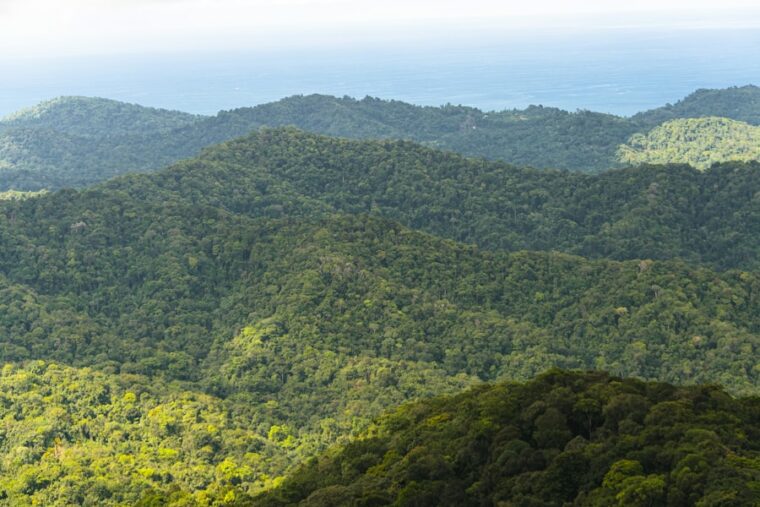French Guiana is an overseas department and region of France located on the northeastern coast of South America. It is bordered by Brazil to the south and east, Suriname to the west, and the Atlantic Ocean to the north. The capital city is Cayenne, and the official language is French. The population of French Guiana is diverse, with a mix of Creole, Maroon, Amerindian, and European cultures. The region is known for its rich biodiversity, including tropical rainforests, savannas, and wetlands. French Guiana is also home to the Guiana Space Centre, a major spaceport that is used by the European Space Agency and the French space agency, CNES.
French Guiana has a tropical climate with high temperatures and humidity throughout the year. The rainy season typically lasts from December to July, with the heaviest rainfall occurring between April and June. The dry season runs from August to November. The region is known for its stunning natural beauty, with pristine beaches, lush rainforests, and diverse wildlife. French Guiana also has a rich cultural heritage, with a mix of African, European, and indigenous influences. The cuisine is a reflection of this diversity, with dishes featuring local ingredients such as cassava, plantains, and seafood.
Getting to French Guiana
There are several ways to get to French Guiana, with most visitors arriving by air. The main international airport is Cayenne – Félix Eboué Airport, which is located just outside the capital city. There are direct flights to French Guiana from Paris, as well as connecting flights from other major cities in Europe and the Caribbean. Another option is to travel to neighboring countries such as Brazil or Suriname and then cross the border into French Guiana by land. There are also regular ferry services between French Guiana and neighboring countries.
Once in French Guiana, getting around is relatively easy thanks to a well-developed road network. Car rentals are available at the airport and in major cities, and there are also public buses that connect different parts of the region. Taxis are another convenient option for getting around, especially in urban areas. For those looking to explore the more remote parts of French Guiana, guided tours and boat trips are available.
Top Attractions in French Guiana
French Guiana offers a wide range of attractions for visitors to explore. One of the most popular destinations is the Îles du Salut, a group of small islands located off the coast of Kourou. These islands were once home to a notorious penal colony, and today visitors can tour the ruins of the prison buildings and learn about the history of the area. Another must-see attraction is the Guiana Space Centre, which offers guided tours that provide a behind-the-scenes look at Europe’s primary spaceport.
For nature lovers, French Guiana is a paradise with its stunning natural landscapes and diverse wildlife. The Amazon rainforest covers much of the region and is home to an incredible array of plant and animal species. The Cacao Nature Reserve is a great place to explore the rainforest on foot, with hiking trails that lead through dense jungle and past beautiful waterfalls. The Kaw Marshes are another natural wonder, with vast wetlands that are home to a variety of bird species including herons, egrets, and kingfishers.
Exploring the Culture and History of French Guiana
French Guiana has a rich cultural heritage that reflects its diverse population and history. The region’s indigenous people have a strong presence, with several Amerindian communities that continue to practice traditional customs and crafts. Visitors can learn about Amerindian culture at the Tumuc-Humac Ethnobotanical Park, which showcases traditional medicine and handicrafts.
The history of French Guiana is also fascinating, with a mix of European colonization, slavery, and penal colonies. The town of Saint-Laurent-du-Maroni was once home to one of the largest penal colonies in France, and today visitors can tour the Camp de la Transportation to learn about the harsh conditions endured by prisoners. The town also has a strong Maroon heritage, with a vibrant culture that includes music, dance, and traditional crafts.
Outdoor Adventures in French Guiana
French Guiana is a paradise for outdoor enthusiasts, with a wide range of activities to enjoy in its stunning natural landscapes. The region’s rivers are perfect for kayaking and canoeing, with opportunities to paddle through dense rainforest and spot wildlife along the way. The Maroni River is particularly popular for kayaking trips, with its calm waters and beautiful scenery.
For those who prefer to stay on land, hiking is a great way to explore French Guiana’s diverse terrain. The Tumuc-Humac Mountains offer challenging trails that lead through dense jungle and up steep slopes to breathtaking viewpoints. The region also has several nature reserves that are perfect for birdwatching and wildlife spotting.
Where to Stay and Eat in French Guiana
French Guiana offers a range of accommodation options to suit every budget and preference. In Cayenne and other major cities, visitors will find a selection of hotels ranging from luxury resorts to budget-friendly guesthouses. There are also eco-lodges located in more remote areas that offer a unique opportunity to stay in the heart of the rainforest.
When it comes to dining, French Guiana’s cuisine is a reflection of its diverse cultural influences. Creole dishes are popular throughout the region, with flavors that are influenced by African, European, and indigenous traditions. Seafood is also a staple of the local diet, with fresh fish and shellfish featured in many dishes. Visitors can sample traditional Creole cuisine at local restaurants or try street food from vendors selling snacks such as accras (fried fritters) and bokits (sandwiches).
Practical Tips for Traveling in French Guiana
Before traveling to French Guiana, it’s important to be aware of any entry requirements such as visas or vaccinations. Visitors should also be prepared for the tropical climate by packing lightweight clothing, sunscreen, insect repellent, and other essentials for staying comfortable in hot and humid conditions.
French Guiana uses the euro as its currency, so it’s a good idea to exchange money before arriving or withdraw cash from ATMs once in the region. Credit cards are widely accepted in major cities but may not be as readily used in more remote areas.
When exploring French Guiana’s natural landscapes, it’s important to respect the environment and follow any guidelines provided by tour operators or park rangers. This includes staying on designated trails, not disturbing wildlife, and properly disposing of any waste.
Overall, French Guiana offers a unique blend of natural beauty, cultural heritage, and outdoor adventures that make it an unforgettable destination for travelers seeking an off-the-beaten-path experience in South America. Whether exploring ancient ruins on Îles du Salut or kayaking through pristine rainforest rivers, visitors will find plenty to discover in this captivating region.


